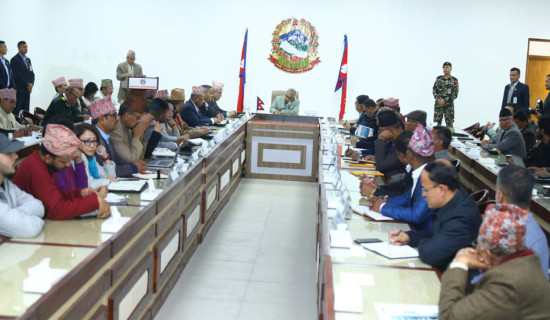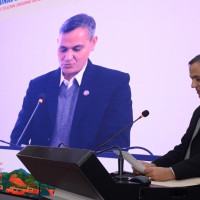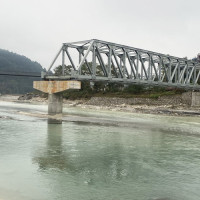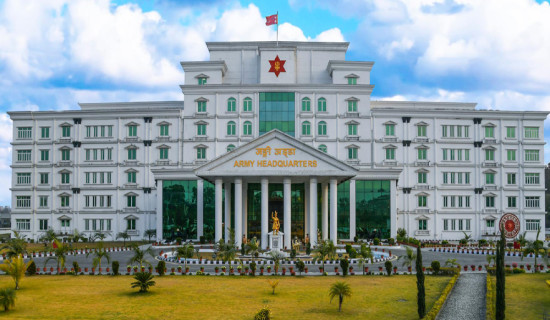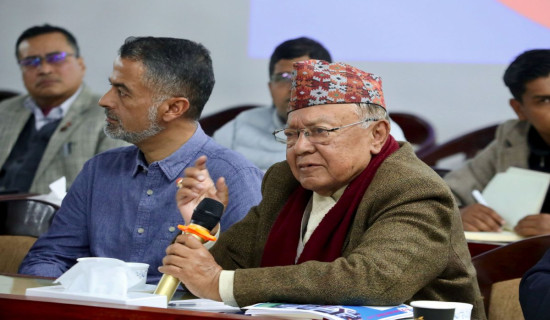- Tuesday, 23 December 2025
Meat market heats up for Dashain festival
By Laxman Kafle
Kathmandu, Oct.2: Dashain has already begun and all Nepalis are already in a festive mood. Those living away from home, have returned home or are on their way home. Sunday is the seventh day of the festival. People call it Fulpati and the government holiday begins from this day.
By Monday, most family members gather at one place, cut he-goats and begin to enjoy meat. There is a practice that people sacrifice goats to Goddess Durga on the day of Ashtami, enjoy the meat as Prasad. They give it to the guests who visit them from the day of Vijaya Dashami to receive Tika.
Believe it or not, Nepali people consume the meat of 2.5 million he-goats in a week of Dashain, not to talk about other animals like buffaloes, pigs and chicken slaughtered for meat in this festival.
Traditionally, livestock especially goats, buffaloes, pigs, pigeons and ducks are sacrificed to the deities, and people consume their meat throughout this festival.
Most households sacrifice goats, chickens, ducks and buffaloes in their homes based on their personal and cultural beliefs depending on the caste system.
Above 2.5 million goats will be consumed across the country during Dashain festival, said Dr. Chandra Dhakal, senior livestock officer at the Department of Livestock Services.
However, there is no official statistics of the total number of animals and chickens that are sacrificed during the festival, but it is estimated that above 2.5 million of goats, thousands of buffaloes, pigeons and ducks are killed to appease Goddess Durga and provide meat for the extended feasting during the Dashain festival in the country, he said.
The government has claimed that Nepal’s domestic market is almost able to meet the local demand of livestock at present while the people had to rely on imports from Tibet and India to meet their meat demands until a few years ago. The government had already declared that the country had become self-reliant in meat and meat-related goods.
However, only nominal number of goats and buffaloes are being imported from India and mountain goats from Tibet till date. However, due to COVID-19 pandemic and the closure of the border between Nepal and China, the mountain goats (Chyangras) could not arrive in Nepal from Tibet in the past two years. Due to this, the price of mountain goats has increased significantly.
Enough supply of goats in market
About 5 million goats are used for meat items every year. Out of this, almost 60 per cent get consumed during the Dashain and Tihar festivals. The total population of goats in Nepal is estimated at 13.4 million, according to the Department of Livestock Services.
Out of 2.5 million goats consumed across the country, about 70,000 goats, including mountain goats, 5,000 buffaloes and a large number of chickens and ducks will be sacrificed for meat only in the Valley during Dashain, said Dr. Dhakal.
Likewise, around 15,000 ducks 1,000 pigs and 60,000 tonnes of fish are consumed in the Kathmandu Valley alone. At normal times, Valley people consume around 1,200 goats a day.
The average annual meat consumption has increased by 2 to 5 per cent in the country. Demand for meat in the Kathmandu Valley is expected to increase this Dashain than last year due to a reduction in the cases of COVID-19. Last year, around 55,000 goats were consumed in the Valley. However, the growing cases of dengue in 76 of 77 districts may reduce meat consumption this year.
“There will be no issue regarding goat supply during this festive season as domestic production is sufficient to cater to the demand,” Dhakal said.
In the past, traders used to import goats from India due to difficulty in collecting goats from the villages of the country, but for the last few years,
they were collecting goats from various parts of the districts due to tightened quarantine provision.
The goats sold in the Valley are brought from Itahari, Kohalpur, Nepalgunj, Dang, Salyan, Morang, Surkhet, Udayapur, Kavrepalanchowk, Dhading, Makwanpur and Nuwakot, among other districts. Mountain goats are supplied only from mountain districts,
including Manang, Mustang and Dolpa.
“Consuming local goats is good for both the farmers and the consumers. However, the price of meat will increase slightly this year too. But this will encourage the farmers to rear more goats in the days to come, which will contribute to the decline in meat prices,” said Dhakal.
For the last two years, the traders have been supplying goats and mountain goats to the Kathmandu Valley from various parts of the country after quarantine provision was tightened along Nepal-India border, Krishna Prasad Sedhai, senior vice-president of Nepal Goat Entrepreneurs’ Association, said.
Traders are now selling goats in the main markets of the Valley like Kalanki, Tukucha, and Sallaghari, Bhaktapur.
However, there will be a shortage of mountain goats in the market this year as only around 5,000 goats have arrived in the market from Mustang, Manang, Dolpa and Darchula. Around 30,000 mountain goats will be consumed across the country during Dashain.
Messy market
The import of goats has decreased significantly over the last few years due to the improvement in the supply along with local production and tightened quarantine check.
Only around 50,700 goats entered Nepal from abroad in the fiscal year 2021/22 while 503,600 goats had been imported in 2017/18. Similarly, 26,700 goats were imported in fiscal year 2018/19 and 9,900 goats in the fiscal year 2019/20 and 8,200 goats in the fiscal year 2020/21. The import of mountain goats from Tibet has also stopped after tightening of the northern border due to COVID-19 pandemic.
The import of goats from India increased slightly last year than the previous fiscal year. However, there was no quantity of goats imported in the first two months of the current fiscal year.
Goat entrepreneur Sedhai said that illegal import of goats from India due to open border is not only affecting the market but also local farmers did not get the reasonable price of their goats.
“For the farmers who are waiting for Dashain to meet their Dashain expenses by selling goats at a good price, their plans are often thwarted as goats are brought illegally from India,” he said.
According to him, traders had been compelled to return goats supplied to Kathmandu from various parts of the country after they were not sold even last year.
There is no fixed place to sell goats and to control the market price, no proper market monitoring bodies due to which the market of goats turns messy during festivals.
“We can supply goats as per the need across the country, including urban cities if the government controls the illegal import of goats. It not only supports the management of the market but also helps the local farmers to get reasonable prices for their cattle,” he said.
Entrepreneurs who supplied goats in cities, including Kathmandu Valley, Pokhara are purchasing goats from the local traders paying from Rs. 550 to Rs. 600 per kg for a live goat. So, farmers are hardly getting Rs. 400-Rs. 450 per kg in a live goat.
Traders are selling goats everywhere in Kathmandu. Due to the market becoming messy, consumers are compelled to purchase goats as per the quotation of traders and there is no guarantee that all goats are healthy for consumption.
Price soars as demand rises
Deepak Thapa, president of the Nepal Livestock Traders Association, said the price of live goat increased by up to Rs. 100 per kg this festival compared to the last year.
Local live goats cost Rs. 700 to Rs. 750 per kg this year while it was Rs. 600-650 per kilogram last year. The price of goat meat stands at Rs. 1,200 to Rs. 1,300 per kilogram at present, he said, adding that the price of meat might increase to Rs. 1,500 per kilogram.
Similarly, the price of Chyangra increased by Rs. 200 per kg this year compared to the last year.
Currently, traders are selling live Chyangra at Rs. 1,300 to Rs. 1,400 per kg while it was Rs. 1,100 to Rs. 1,200 a year ago in Dashain. Readymade meat of Chyangra may cost as high as Rs. 3,500 per kg.
Due to short supply of Chyangra, its price has been increasing for the last two years. Two years ago, a kg of live Chyangra was Rs. 850 in the Valley.
There is no fixed price, so the traders are selling goats at their own wish.
He said that since the demand for meat is high during Dashain, the price of prepared meat and live meat will increase every year.
He said that every year during the festival, the price of meat increases by Rs. 100 to Rs. 200 per kg and drops again after Dashain.
Meanwhile, the government’s Food Management and Trading Company (FMTC) has started selling live goats at Rs. 670 per kilogram and mountain goats at Rs. 1,250 per kg with discount of Rs. 10 per kg. This year’s live goat price is Rs. 30 per kg more than last year.



